Examining Customer Attitude towards Hotels: Promotional Messages Study
VerifiedAdded on 2023/06/08
|38
|11034
|119
Report
AI Summary
This report delves into the research methodology and data analysis concerning customer attitudes towards hotels, specifically examining the impact of rational and emotional promotional messages. The study employs a positivism philosophy and a deductive approach, utilizing quantitative data collected from a sample of 200 hotel customers (100 from budget hotels and 100 from luxury hotels). Data collection involved close-ended questionnaires, and analysis was conducted using SPSS software, including Two-Way ANOVA tests, to assess attitudes towards the hotel, the promotional messages, and the intention to recommend. The findings reveal varying customer responses based on the type of hotel (budget vs. luxury) and the nature of the message (rational vs. emotional), providing insights into the effectiveness of different promotional strategies in shaping customer perceptions and behaviors within the hotel industry. The report concludes with overall findings and recommendations for hotel marketing and customer engagement.
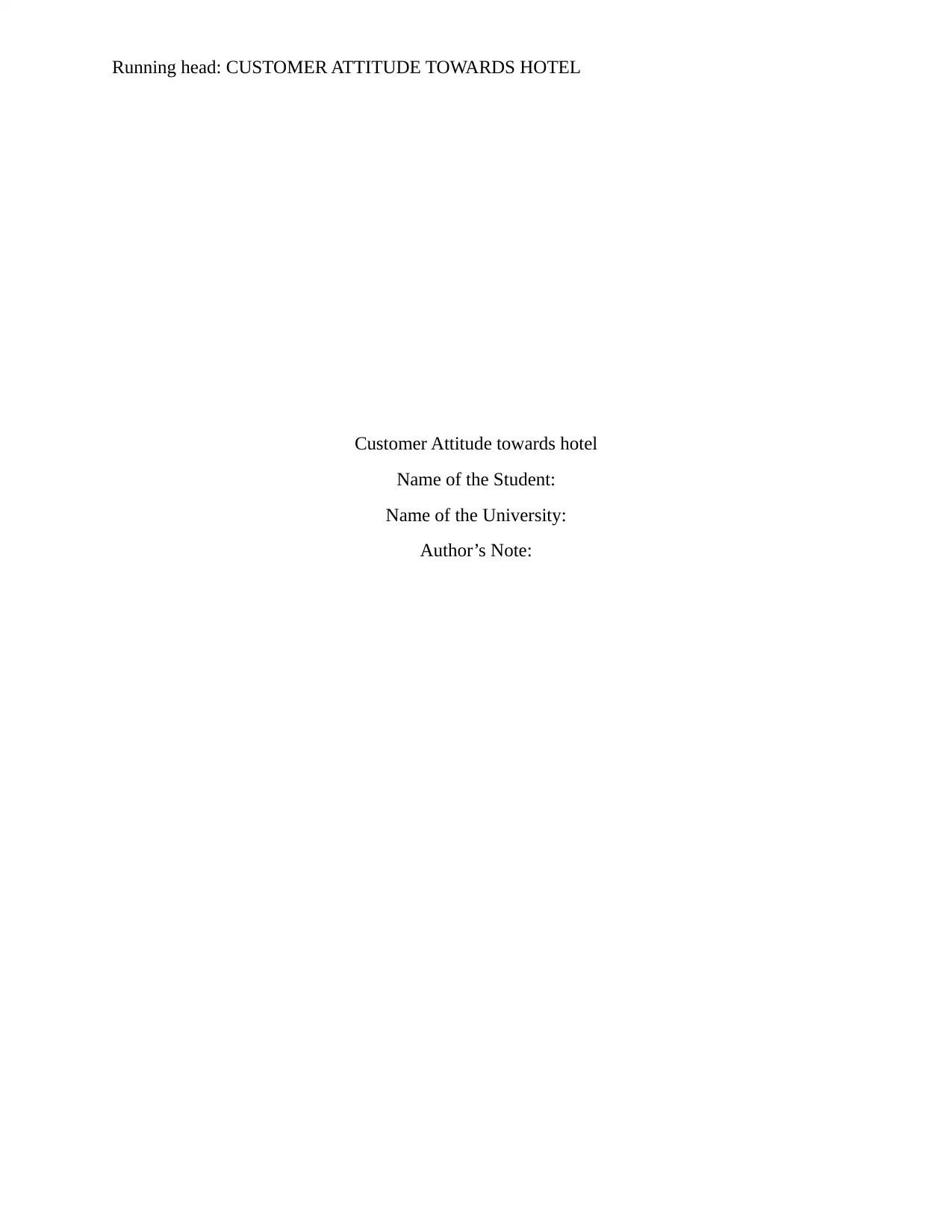
Running head: CUSTOMER ATTITUDE TOWARDS HOTEL
Customer Attitude towards hotel
Name of the Student:
Name of the University:
Author’s Note:
Customer Attitude towards hotel
Name of the Student:
Name of the University:
Author’s Note:
Paraphrase This Document
Need a fresh take? Get an instant paraphrase of this document with our AI Paraphraser
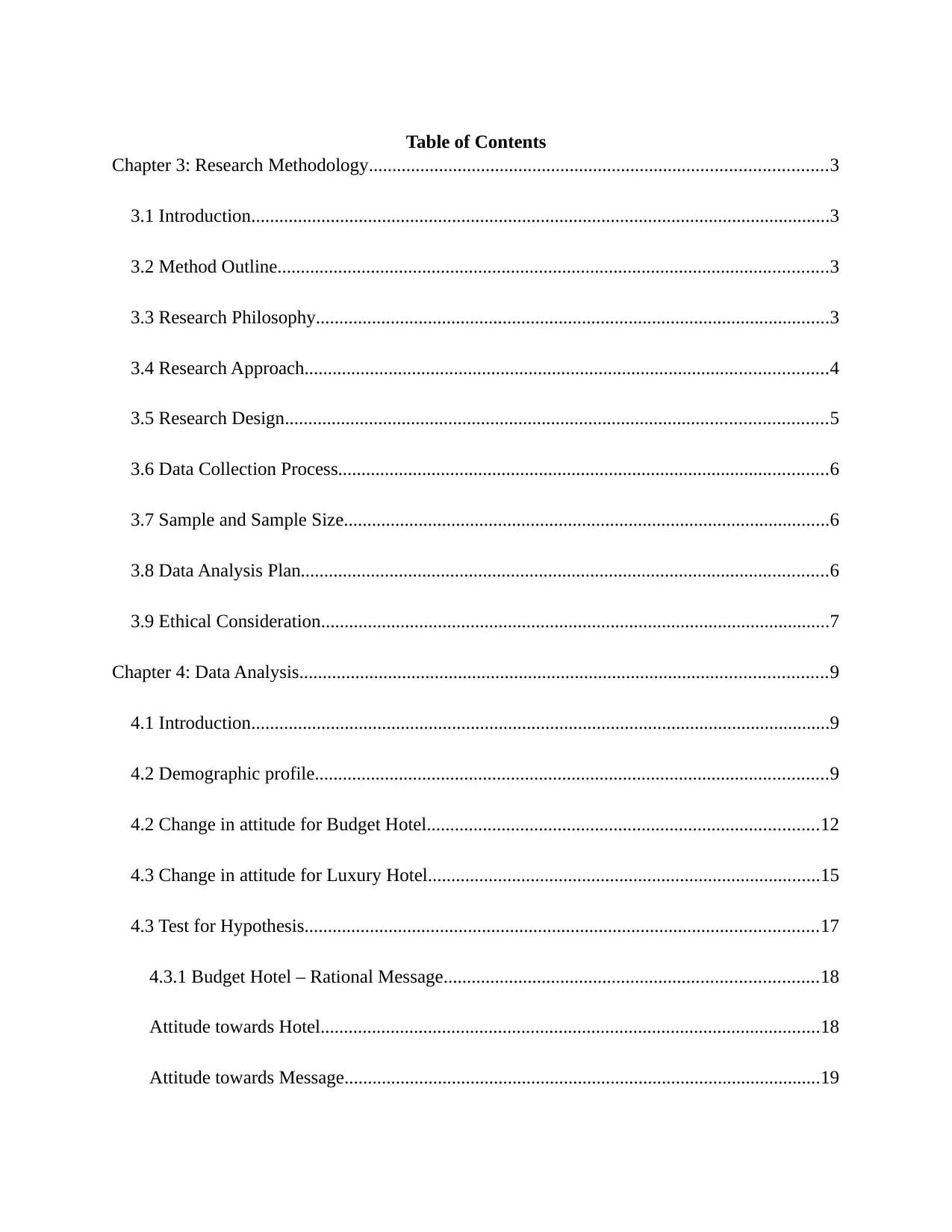
Table of Contents
Chapter 3: Research Methodology..................................................................................................3
3.1 Introduction............................................................................................................................3
3.2 Method Outline......................................................................................................................3
3.3 Research Philosophy..............................................................................................................3
3.4 Research Approach................................................................................................................4
3.5 Research Design....................................................................................................................5
3.6 Data Collection Process.........................................................................................................6
3.7 Sample and Sample Size........................................................................................................6
3.8 Data Analysis Plan.................................................................................................................6
3.9 Ethical Consideration.............................................................................................................7
Chapter 4: Data Analysis.................................................................................................................9
4.1 Introduction............................................................................................................................9
4.2 Demographic profile..............................................................................................................9
4.2 Change in attitude for Budget Hotel....................................................................................12
4.3 Change in attitude for Luxury Hotel....................................................................................15
4.3 Test for Hypothesis..............................................................................................................17
4.3.1 Budget Hotel – Rational Message................................................................................18
Attitude towards Hotel...........................................................................................................18
Attitude towards Message......................................................................................................19
Chapter 3: Research Methodology..................................................................................................3
3.1 Introduction............................................................................................................................3
3.2 Method Outline......................................................................................................................3
3.3 Research Philosophy..............................................................................................................3
3.4 Research Approach................................................................................................................4
3.5 Research Design....................................................................................................................5
3.6 Data Collection Process.........................................................................................................6
3.7 Sample and Sample Size........................................................................................................6
3.8 Data Analysis Plan.................................................................................................................6
3.9 Ethical Consideration.............................................................................................................7
Chapter 4: Data Analysis.................................................................................................................9
4.1 Introduction............................................................................................................................9
4.2 Demographic profile..............................................................................................................9
4.2 Change in attitude for Budget Hotel....................................................................................12
4.3 Change in attitude for Luxury Hotel....................................................................................15
4.3 Test for Hypothesis..............................................................................................................17
4.3.1 Budget Hotel – Rational Message................................................................................18
Attitude towards Hotel...........................................................................................................18
Attitude towards Message......................................................................................................19
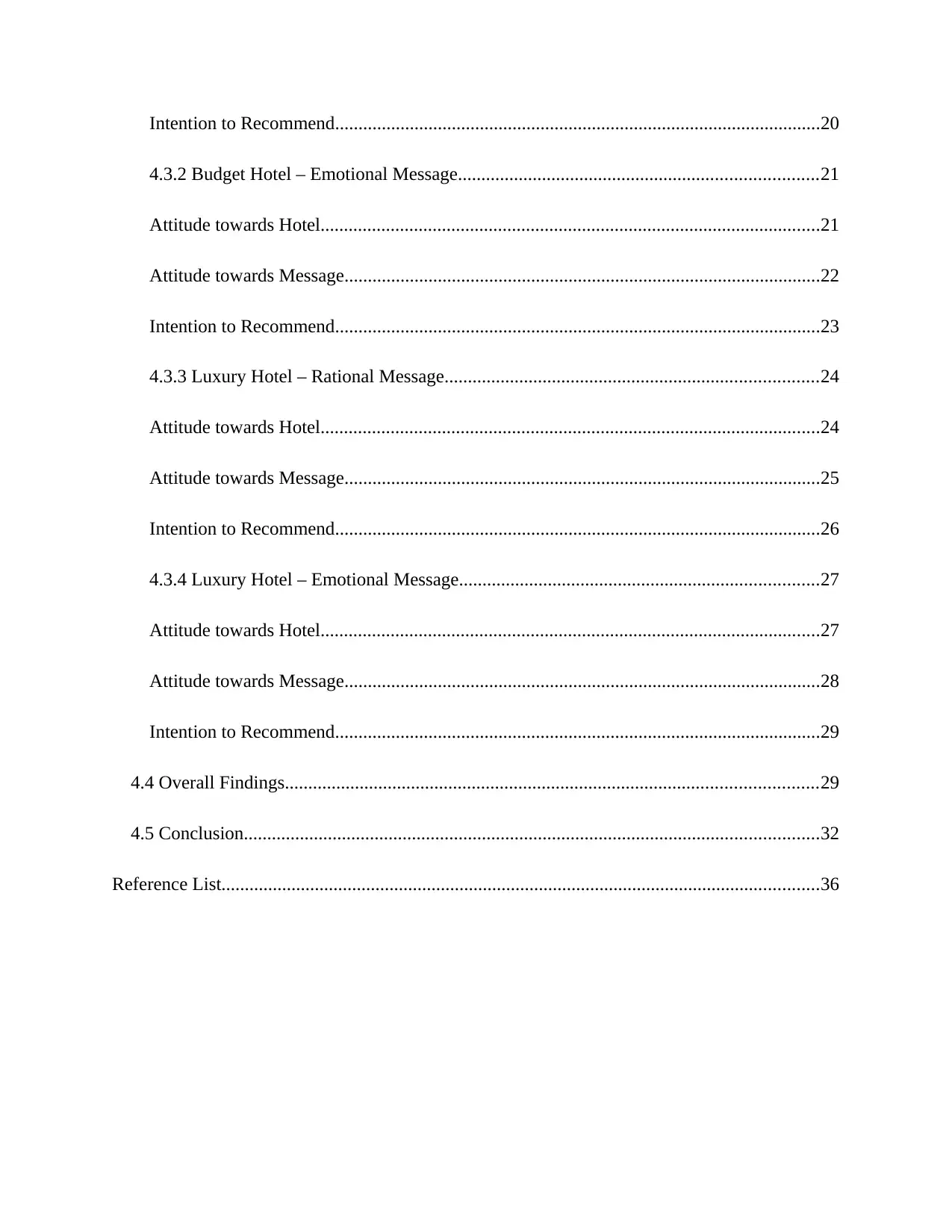
Intention to Recommend........................................................................................................20
4.3.2 Budget Hotel – Emotional Message.............................................................................21
Attitude towards Hotel...........................................................................................................21
Attitude towards Message......................................................................................................22
Intention to Recommend........................................................................................................23
4.3.3 Luxury Hotel – Rational Message................................................................................24
Attitude towards Hotel...........................................................................................................24
Attitude towards Message......................................................................................................25
Intention to Recommend........................................................................................................26
4.3.4 Luxury Hotel – Emotional Message.............................................................................27
Attitude towards Hotel...........................................................................................................27
Attitude towards Message......................................................................................................28
Intention to Recommend........................................................................................................29
4.4 Overall Findings..................................................................................................................29
4.5 Conclusion...........................................................................................................................32
Reference List................................................................................................................................36
4.3.2 Budget Hotel – Emotional Message.............................................................................21
Attitude towards Hotel...........................................................................................................21
Attitude towards Message......................................................................................................22
Intention to Recommend........................................................................................................23
4.3.3 Luxury Hotel – Rational Message................................................................................24
Attitude towards Hotel...........................................................................................................24
Attitude towards Message......................................................................................................25
Intention to Recommend........................................................................................................26
4.3.4 Luxury Hotel – Emotional Message.............................................................................27
Attitude towards Hotel...........................................................................................................27
Attitude towards Message......................................................................................................28
Intention to Recommend........................................................................................................29
4.4 Overall Findings..................................................................................................................29
4.5 Conclusion...........................................................................................................................32
Reference List................................................................................................................................36
⊘ This is a preview!⊘
Do you want full access?
Subscribe today to unlock all pages.

Trusted by 1+ million students worldwide
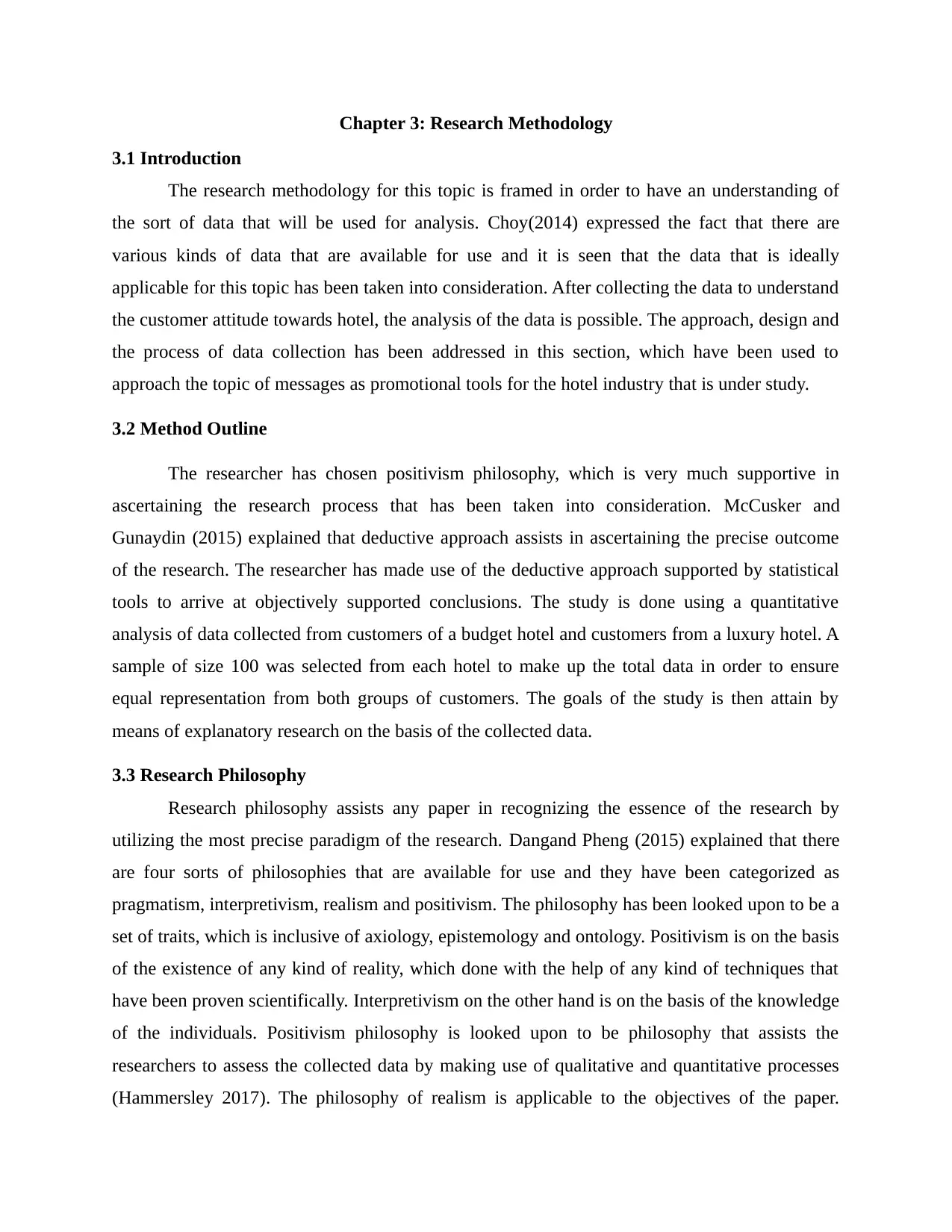
Chapter 3: Research Methodology
3.1 Introduction
The research methodology for this topic is framed in order to have an understanding of
the sort of data that will be used for analysis. Choy(2014) expressed the fact that there are
various kinds of data that are available for use and it is seen that the data that is ideally
applicable for this topic has been taken into consideration. After collecting the data to understand
the customer attitude towards hotel, the analysis of the data is possible. The approach, design and
the process of data collection has been addressed in this section, which have been used to
approach the topic of messages as promotional tools for the hotel industry that is under study.
3.2 Method Outline
The researcher has chosen positivism philosophy, which is very much supportive in
ascertaining the research process that has been taken into consideration. McCusker and
Gunaydin (2015) explained that deductive approach assists in ascertaining the precise outcome
of the research. The researcher has made use of the deductive approach supported by statistical
tools to arrive at objectively supported conclusions. The study is done using a quantitative
analysis of data collected from customers of a budget hotel and customers from a luxury hotel. A
sample of size 100 was selected from each hotel to make up the total data in order to ensure
equal representation from both groups of customers. The goals of the study is then attain by
means of explanatory research on the basis of the collected data.
3.3 Research Philosophy
Research philosophy assists any paper in recognizing the essence of the research by
utilizing the most precise paradigm of the research. Dangand Pheng (2015) explained that there
are four sorts of philosophies that are available for use and they have been categorized as
pragmatism, interpretivism, realism and positivism. The philosophy has been looked upon to be a
set of traits, which is inclusive of axiology, epistemology and ontology. Positivism is on the basis
of the existence of any kind of reality, which done with the help of any kind of techniques that
have been proven scientifically. Interpretivism on the other hand is on the basis of the knowledge
of the individuals. Positivism philosophy is looked upon to be philosophy that assists the
researchers to assess the collected data by making use of qualitative and quantitative processes
(Hammersley 2017). The philosophy of realism is applicable to the objectives of the paper.
3.1 Introduction
The research methodology for this topic is framed in order to have an understanding of
the sort of data that will be used for analysis. Choy(2014) expressed the fact that there are
various kinds of data that are available for use and it is seen that the data that is ideally
applicable for this topic has been taken into consideration. After collecting the data to understand
the customer attitude towards hotel, the analysis of the data is possible. The approach, design and
the process of data collection has been addressed in this section, which have been used to
approach the topic of messages as promotional tools for the hotel industry that is under study.
3.2 Method Outline
The researcher has chosen positivism philosophy, which is very much supportive in
ascertaining the research process that has been taken into consideration. McCusker and
Gunaydin (2015) explained that deductive approach assists in ascertaining the precise outcome
of the research. The researcher has made use of the deductive approach supported by statistical
tools to arrive at objectively supported conclusions. The study is done using a quantitative
analysis of data collected from customers of a budget hotel and customers from a luxury hotel. A
sample of size 100 was selected from each hotel to make up the total data in order to ensure
equal representation from both groups of customers. The goals of the study is then attain by
means of explanatory research on the basis of the collected data.
3.3 Research Philosophy
Research philosophy assists any paper in recognizing the essence of the research by
utilizing the most precise paradigm of the research. Dangand Pheng (2015) explained that there
are four sorts of philosophies that are available for use and they have been categorized as
pragmatism, interpretivism, realism and positivism. The philosophy has been looked upon to be a
set of traits, which is inclusive of axiology, epistemology and ontology. Positivism is on the basis
of the existence of any kind of reality, which done with the help of any kind of techniques that
have been proven scientifically. Interpretivism on the other hand is on the basis of the knowledge
of the individuals. Positivism philosophy is looked upon to be philosophy that assists the
researchers to assess the collected data by making use of qualitative and quantitative processes
(Hammersley 2017). The philosophy of realism is applicable to the objectives of the paper.
Paraphrase This Document
Need a fresh take? Get an instant paraphrase of this document with our AI Paraphraser
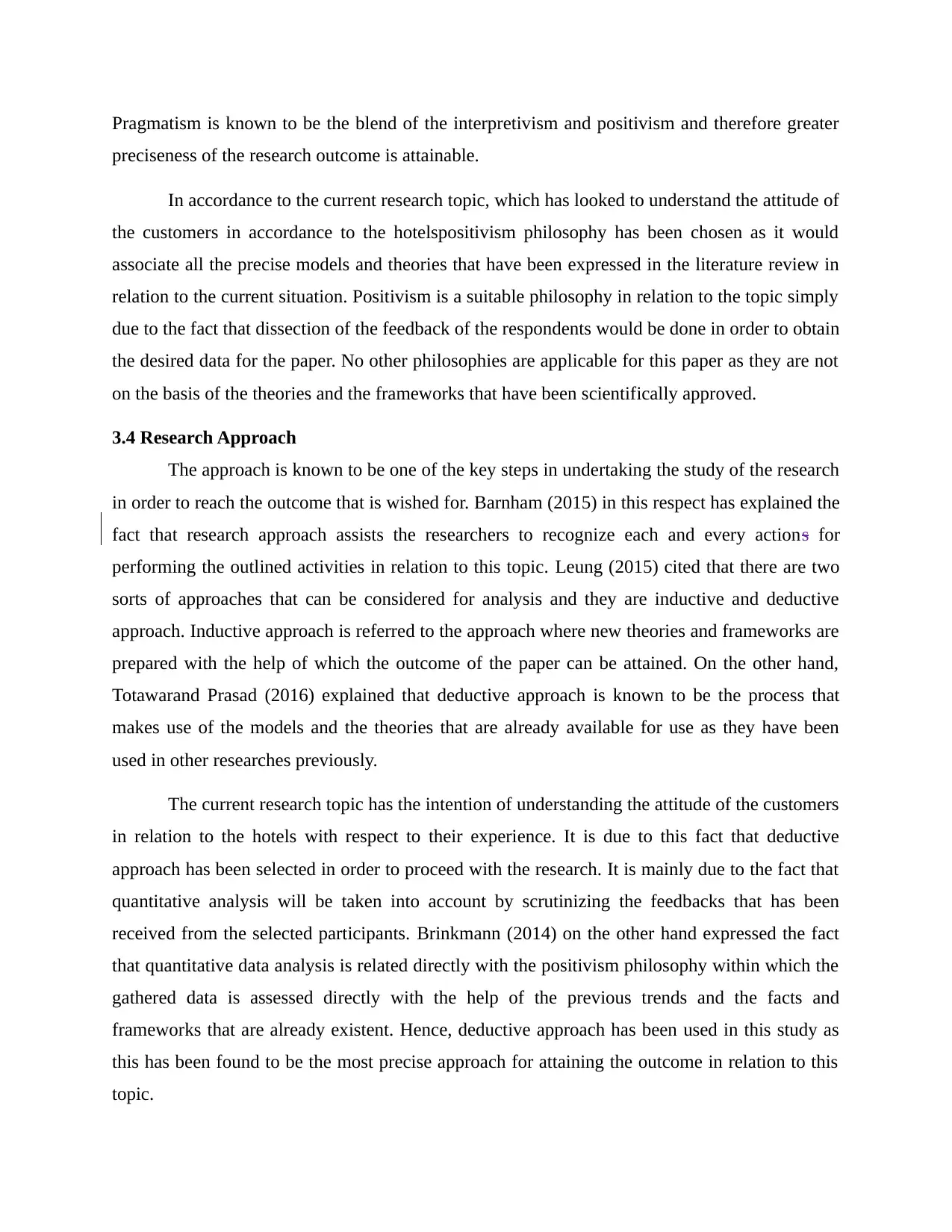
Pragmatism is known to be the blend of the interpretivism and positivism and therefore greater
preciseness of the research outcome is attainable.
In accordance to the current research topic, which has looked to understand the attitude of
the customers in accordance to the hotelspositivism philosophy has been chosen as it would
associate all the precise models and theories that have been expressed in the literature review in
relation to the current situation. Positivism is a suitable philosophy in relation to the topic simply
due to the fact that dissection of the feedback of the respondents would be done in order to obtain
the desired data for the paper. No other philosophies are applicable for this paper as they are not
on the basis of the theories and the frameworks that have been scientifically approved.
3.4 Research Approach
The approach is known to be one of the key steps in undertaking the study of the research
in order to reach the outcome that is wished for. Barnham (2015) in this respect has explained the
fact that research approach assists the researchers to recognize each and every actions for
performing the outlined activities in relation to this topic. Leung (2015) cited that there are two
sorts of approaches that can be considered for analysis and they are inductive and deductive
approach. Inductive approach is referred to the approach where new theories and frameworks are
prepared with the help of which the outcome of the paper can be attained. On the other hand,
Totawarand Prasad (2016) explained that deductive approach is known to be the process that
makes use of the models and the theories that are already available for use as they have been
used in other researches previously.
The current research topic has the intention of understanding the attitude of the customers
in relation to the hotels with respect to their experience. It is due to this fact that deductive
approach has been selected in order to proceed with the research. It is mainly due to the fact that
quantitative analysis will be taken into account by scrutinizing the feedbacks that has been
received from the selected participants. Brinkmann (2014) on the other hand expressed the fact
that quantitative data analysis is related directly with the positivism philosophy within which the
gathered data is assessed directly with the help of the previous trends and the facts and
frameworks that are already existent. Hence, deductive approach has been used in this study as
this has been found to be the most precise approach for attaining the outcome in relation to this
topic.
preciseness of the research outcome is attainable.
In accordance to the current research topic, which has looked to understand the attitude of
the customers in accordance to the hotelspositivism philosophy has been chosen as it would
associate all the precise models and theories that have been expressed in the literature review in
relation to the current situation. Positivism is a suitable philosophy in relation to the topic simply
due to the fact that dissection of the feedback of the respondents would be done in order to obtain
the desired data for the paper. No other philosophies are applicable for this paper as they are not
on the basis of the theories and the frameworks that have been scientifically approved.
3.4 Research Approach
The approach is known to be one of the key steps in undertaking the study of the research
in order to reach the outcome that is wished for. Barnham (2015) in this respect has explained the
fact that research approach assists the researchers to recognize each and every actions for
performing the outlined activities in relation to this topic. Leung (2015) cited that there are two
sorts of approaches that can be considered for analysis and they are inductive and deductive
approach. Inductive approach is referred to the approach where new theories and frameworks are
prepared with the help of which the outcome of the paper can be attained. On the other hand,
Totawarand Prasad (2016) explained that deductive approach is known to be the process that
makes use of the models and the theories that are already available for use as they have been
used in other researches previously.
The current research topic has the intention of understanding the attitude of the customers
in relation to the hotels with respect to their experience. It is due to this fact that deductive
approach has been selected in order to proceed with the research. It is mainly due to the fact that
quantitative analysis will be taken into account by scrutinizing the feedbacks that has been
received from the selected participants. Brinkmann (2014) on the other hand expressed the fact
that quantitative data analysis is related directly with the positivism philosophy within which the
gathered data is assessed directly with the help of the previous trends and the facts and
frameworks that are already existent. Hence, deductive approach has been used in this study as
this has been found to be the most precise approach for attaining the outcome in relation to this
topic.
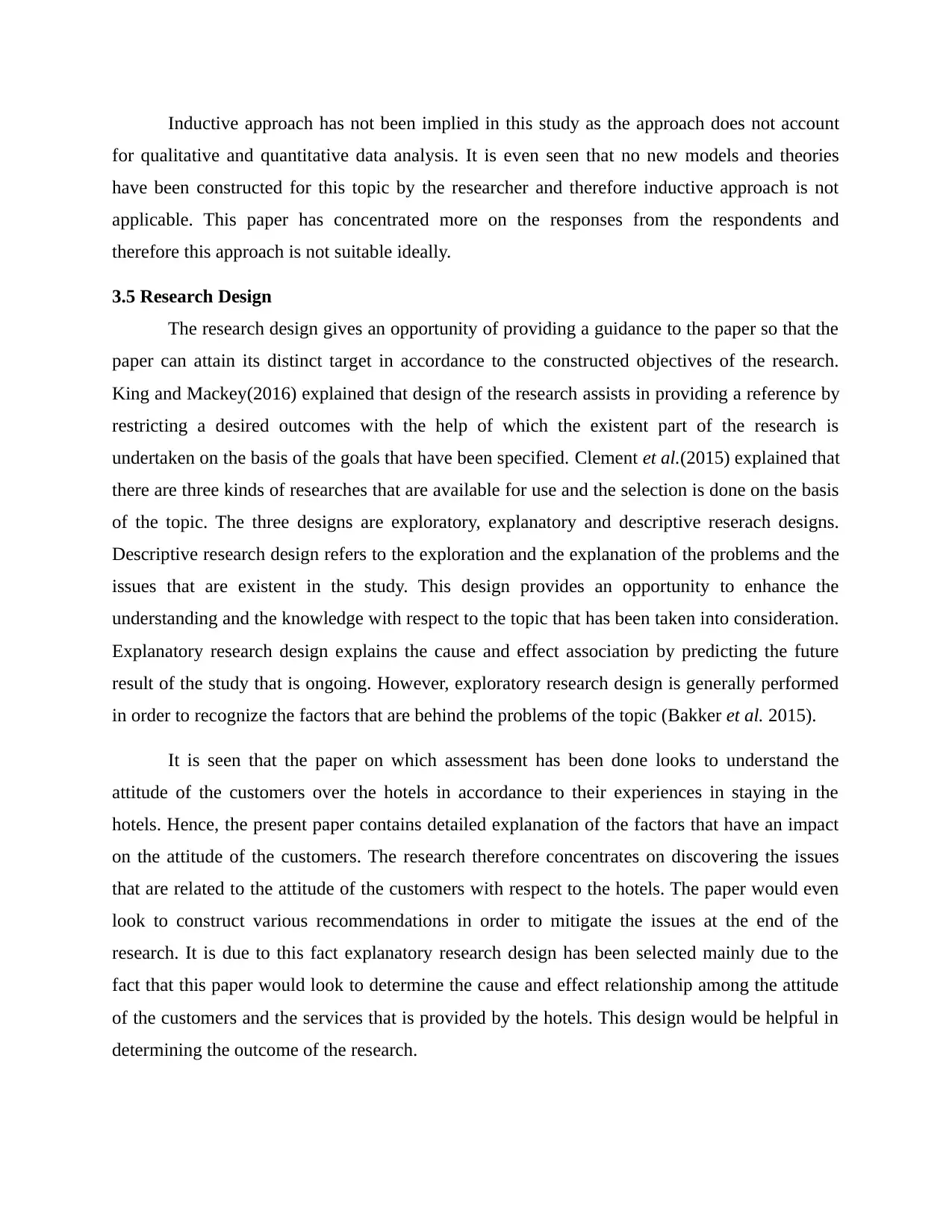
Inductive approach has not been implied in this study as the approach does not account
for qualitative and quantitative data analysis. It is even seen that no new models and theories
have been constructed for this topic by the researcher and therefore inductive approach is not
applicable. This paper has concentrated more on the responses from the respondents and
therefore this approach is not suitable ideally.
3.5 Research Design
The research design gives an opportunity of providing a guidance to the paper so that the
paper can attain its distinct target in accordance to the constructed objectives of the research.
King and Mackey(2016) explained that design of the research assists in providing a reference by
restricting a desired outcomes with the help of which the existent part of the research is
undertaken on the basis of the goals that have been specified. Clement et al.(2015) explained that
there are three kinds of researches that are available for use and the selection is done on the basis
of the topic. The three designs are exploratory, explanatory and descriptive reserach designs.
Descriptive research design refers to the exploration and the explanation of the problems and the
issues that are existent in the study. This design provides an opportunity to enhance the
understanding and the knowledge with respect to the topic that has been taken into consideration.
Explanatory research design explains the cause and effect association by predicting the future
result of the study that is ongoing. However, exploratory research design is generally performed
in order to recognize the factors that are behind the problems of the topic (Bakker et al. 2015).
It is seen that the paper on which assessment has been done looks to understand the
attitude of the customers over the hotels in accordance to their experiences in staying in the
hotels. Hence, the present paper contains detailed explanation of the factors that have an impact
on the attitude of the customers. The research therefore concentrates on discovering the issues
that are related to the attitude of the customers with respect to the hotels. The paper would even
look to construct various recommendations in order to mitigate the issues at the end of the
research. It is due to this fact explanatory research design has been selected mainly due to the
fact that this paper would look to determine the cause and effect relationship among the attitude
of the customers and the services that is provided by the hotels. This design would be helpful in
determining the outcome of the research.
for qualitative and quantitative data analysis. It is even seen that no new models and theories
have been constructed for this topic by the researcher and therefore inductive approach is not
applicable. This paper has concentrated more on the responses from the respondents and
therefore this approach is not suitable ideally.
3.5 Research Design
The research design gives an opportunity of providing a guidance to the paper so that the
paper can attain its distinct target in accordance to the constructed objectives of the research.
King and Mackey(2016) explained that design of the research assists in providing a reference by
restricting a desired outcomes with the help of which the existent part of the research is
undertaken on the basis of the goals that have been specified. Clement et al.(2015) explained that
there are three kinds of researches that are available for use and the selection is done on the basis
of the topic. The three designs are exploratory, explanatory and descriptive reserach designs.
Descriptive research design refers to the exploration and the explanation of the problems and the
issues that are existent in the study. This design provides an opportunity to enhance the
understanding and the knowledge with respect to the topic that has been taken into consideration.
Explanatory research design explains the cause and effect association by predicting the future
result of the study that is ongoing. However, exploratory research design is generally performed
in order to recognize the factors that are behind the problems of the topic (Bakker et al. 2015).
It is seen that the paper on which assessment has been done looks to understand the
attitude of the customers over the hotels in accordance to their experiences in staying in the
hotels. Hence, the present paper contains detailed explanation of the factors that have an impact
on the attitude of the customers. The research therefore concentrates on discovering the issues
that are related to the attitude of the customers with respect to the hotels. The paper would even
look to construct various recommendations in order to mitigate the issues at the end of the
research. It is due to this fact explanatory research design has been selected mainly due to the
fact that this paper would look to determine the cause and effect relationship among the attitude
of the customers and the services that is provided by the hotels. This design would be helpful in
determining the outcome of the research.
⊘ This is a preview!⊘
Do you want full access?
Subscribe today to unlock all pages.

Trusted by 1+ million students worldwide
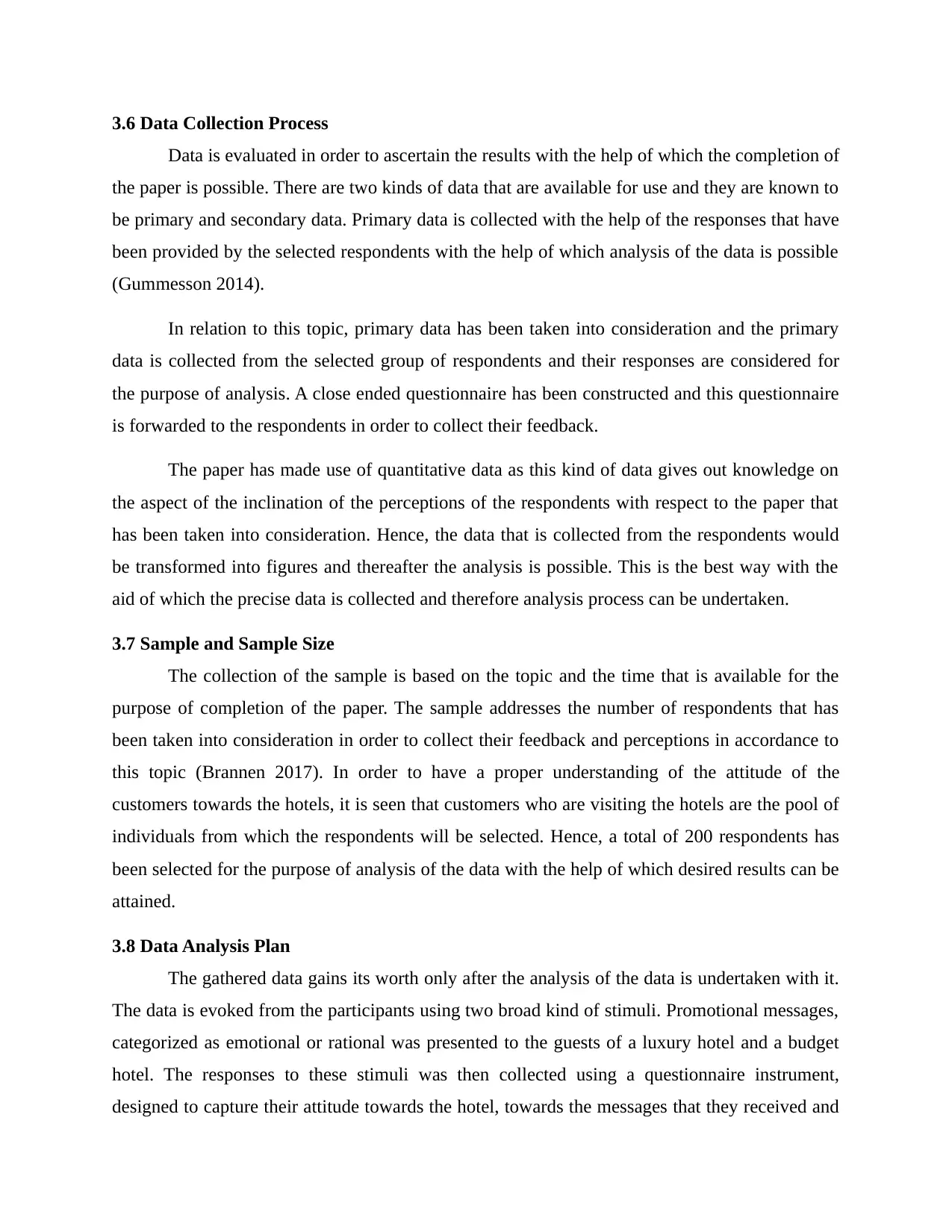
3.6 Data Collection Process
Data is evaluated in order to ascertain the results with the help of which the completion of
the paper is possible. There are two kinds of data that are available for use and they are known to
be primary and secondary data. Primary data is collected with the help of the responses that have
been provided by the selected respondents with the help of which analysis of the data is possible
(Gummesson 2014).
In relation to this topic, primary data has been taken into consideration and the primary
data is collected from the selected group of respondents and their responses are considered for
the purpose of analysis. A close ended questionnaire has been constructed and this questionnaire
is forwarded to the respondents in order to collect their feedback.
The paper has made use of quantitative data as this kind of data gives out knowledge on
the aspect of the inclination of the perceptions of the respondents with respect to the paper that
has been taken into consideration. Hence, the data that is collected from the respondents would
be transformed into figures and thereafter the analysis is possible. This is the best way with the
aid of which the precise data is collected and therefore analysis process can be undertaken.
3.7 Sample and Sample Size
The collection of the sample is based on the topic and the time that is available for the
purpose of completion of the paper. The sample addresses the number of respondents that has
been taken into consideration in order to collect their feedback and perceptions in accordance to
this topic (Brannen 2017). In order to have a proper understanding of the attitude of the
customers towards the hotels, it is seen that customers who are visiting the hotels are the pool of
individuals from which the respondents will be selected. Hence, a total of 200 respondents has
been selected for the purpose of analysis of the data with the help of which desired results can be
attained.
3.8 Data Analysis Plan
The gathered data gains its worth only after the analysis of the data is undertaken with it.
The data is evoked from the participants using two broad kind of stimuli. Promotional messages,
categorized as emotional or rational was presented to the guests of a luxury hotel and a budget
hotel. The responses to these stimuli was then collected using a questionnaire instrument,
designed to capture their attitude towards the hotel, towards the messages that they received and
Data is evaluated in order to ascertain the results with the help of which the completion of
the paper is possible. There are two kinds of data that are available for use and they are known to
be primary and secondary data. Primary data is collected with the help of the responses that have
been provided by the selected respondents with the help of which analysis of the data is possible
(Gummesson 2014).
In relation to this topic, primary data has been taken into consideration and the primary
data is collected from the selected group of respondents and their responses are considered for
the purpose of analysis. A close ended questionnaire has been constructed and this questionnaire
is forwarded to the respondents in order to collect their feedback.
The paper has made use of quantitative data as this kind of data gives out knowledge on
the aspect of the inclination of the perceptions of the respondents with respect to the paper that
has been taken into consideration. Hence, the data that is collected from the respondents would
be transformed into figures and thereafter the analysis is possible. This is the best way with the
aid of which the precise data is collected and therefore analysis process can be undertaken.
3.7 Sample and Sample Size
The collection of the sample is based on the topic and the time that is available for the
purpose of completion of the paper. The sample addresses the number of respondents that has
been taken into consideration in order to collect their feedback and perceptions in accordance to
this topic (Brannen 2017). In order to have a proper understanding of the attitude of the
customers towards the hotels, it is seen that customers who are visiting the hotels are the pool of
individuals from which the respondents will be selected. Hence, a total of 200 respondents has
been selected for the purpose of analysis of the data with the help of which desired results can be
attained.
3.8 Data Analysis Plan
The gathered data gains its worth only after the analysis of the data is undertaken with it.
The data is evoked from the participants using two broad kind of stimuli. Promotional messages,
categorized as emotional or rational was presented to the guests of a luxury hotel and a budget
hotel. The responses to these stimuli was then collected using a questionnaire instrument,
designed to capture their attitude towards the hotel, towards the messages that they received and
Paraphrase This Document
Need a fresh take? Get an instant paraphrase of this document with our AI Paraphraser
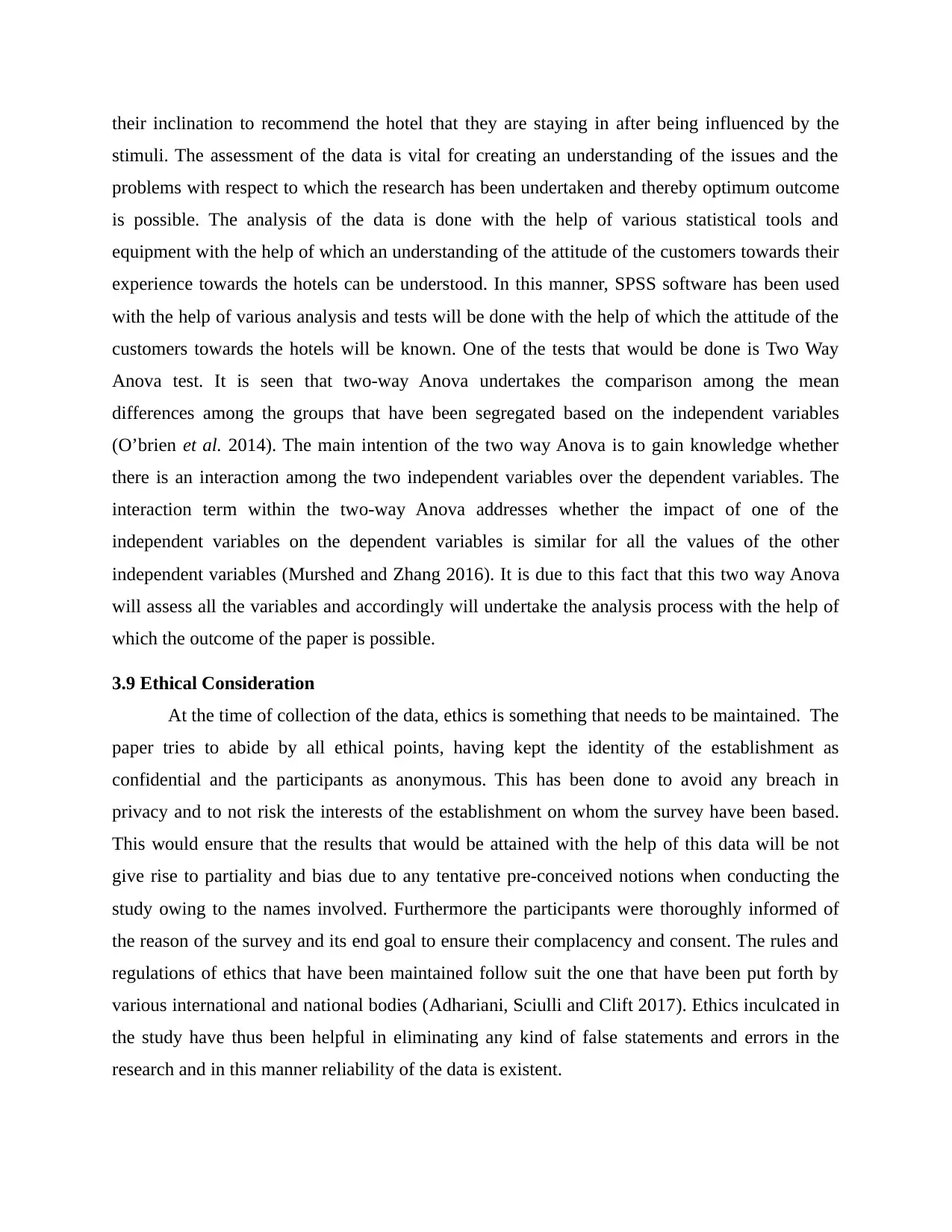
their inclination to recommend the hotel that they are staying in after being influenced by the
stimuli. The assessment of the data is vital for creating an understanding of the issues and the
problems with respect to which the research has been undertaken and thereby optimum outcome
is possible. The analysis of the data is done with the help of various statistical tools and
equipment with the help of which an understanding of the attitude of the customers towards their
experience towards the hotels can be understood. In this manner, SPSS software has been used
with the help of various analysis and tests will be done with the help of which the attitude of the
customers towards the hotels will be known. One of the tests that would be done is Two Way
Anova test. It is seen that two-way Anova undertakes the comparison among the mean
differences among the groups that have been segregated based on the independent variables
(O’brien et al. 2014). The main intention of the two way Anova is to gain knowledge whether
there is an interaction among the two independent variables over the dependent variables. The
interaction term within the two-way Anova addresses whether the impact of one of the
independent variables on the dependent variables is similar for all the values of the other
independent variables (Murshed and Zhang 2016). It is due to this fact that this two way Anova
will assess all the variables and accordingly will undertake the analysis process with the help of
which the outcome of the paper is possible.
3.9 Ethical Consideration
At the time of collection of the data, ethics is something that needs to be maintained. The
paper tries to abide by all ethical points, having kept the identity of the establishment as
confidential and the participants as anonymous. This has been done to avoid any breach in
privacy and to not risk the interests of the establishment on whom the survey have been based.
This would ensure that the results that would be attained with the help of this data will be not
give rise to partiality and bias due to any tentative pre-conceived notions when conducting the
study owing to the names involved. Furthermore the participants were thoroughly informed of
the reason of the survey and its end goal to ensure their complacency and consent. The rules and
regulations of ethics that have been maintained follow suit the one that have been put forth by
various international and national bodies (Adhariani, Sciulli and Clift 2017). Ethics inculcated in
the study have thus been helpful in eliminating any kind of false statements and errors in the
research and in this manner reliability of the data is existent.
stimuli. The assessment of the data is vital for creating an understanding of the issues and the
problems with respect to which the research has been undertaken and thereby optimum outcome
is possible. The analysis of the data is done with the help of various statistical tools and
equipment with the help of which an understanding of the attitude of the customers towards their
experience towards the hotels can be understood. In this manner, SPSS software has been used
with the help of various analysis and tests will be done with the help of which the attitude of the
customers towards the hotels will be known. One of the tests that would be done is Two Way
Anova test. It is seen that two-way Anova undertakes the comparison among the mean
differences among the groups that have been segregated based on the independent variables
(O’brien et al. 2014). The main intention of the two way Anova is to gain knowledge whether
there is an interaction among the two independent variables over the dependent variables. The
interaction term within the two-way Anova addresses whether the impact of one of the
independent variables on the dependent variables is similar for all the values of the other
independent variables (Murshed and Zhang 2016). It is due to this fact that this two way Anova
will assess all the variables and accordingly will undertake the analysis process with the help of
which the outcome of the paper is possible.
3.9 Ethical Consideration
At the time of collection of the data, ethics is something that needs to be maintained. The
paper tries to abide by all ethical points, having kept the identity of the establishment as
confidential and the participants as anonymous. This has been done to avoid any breach in
privacy and to not risk the interests of the establishment on whom the survey have been based.
This would ensure that the results that would be attained with the help of this data will be not
give rise to partiality and bias due to any tentative pre-conceived notions when conducting the
study owing to the names involved. Furthermore the participants were thoroughly informed of
the reason of the survey and its end goal to ensure their complacency and consent. The rules and
regulations of ethics that have been maintained follow suit the one that have been put forth by
various international and national bodies (Adhariani, Sciulli and Clift 2017). Ethics inculcated in
the study have thus been helpful in eliminating any kind of false statements and errors in the
research and in this manner reliability of the data is existent.

⊘ This is a preview!⊘
Do you want full access?
Subscribe today to unlock all pages.

Trusted by 1+ million students worldwide
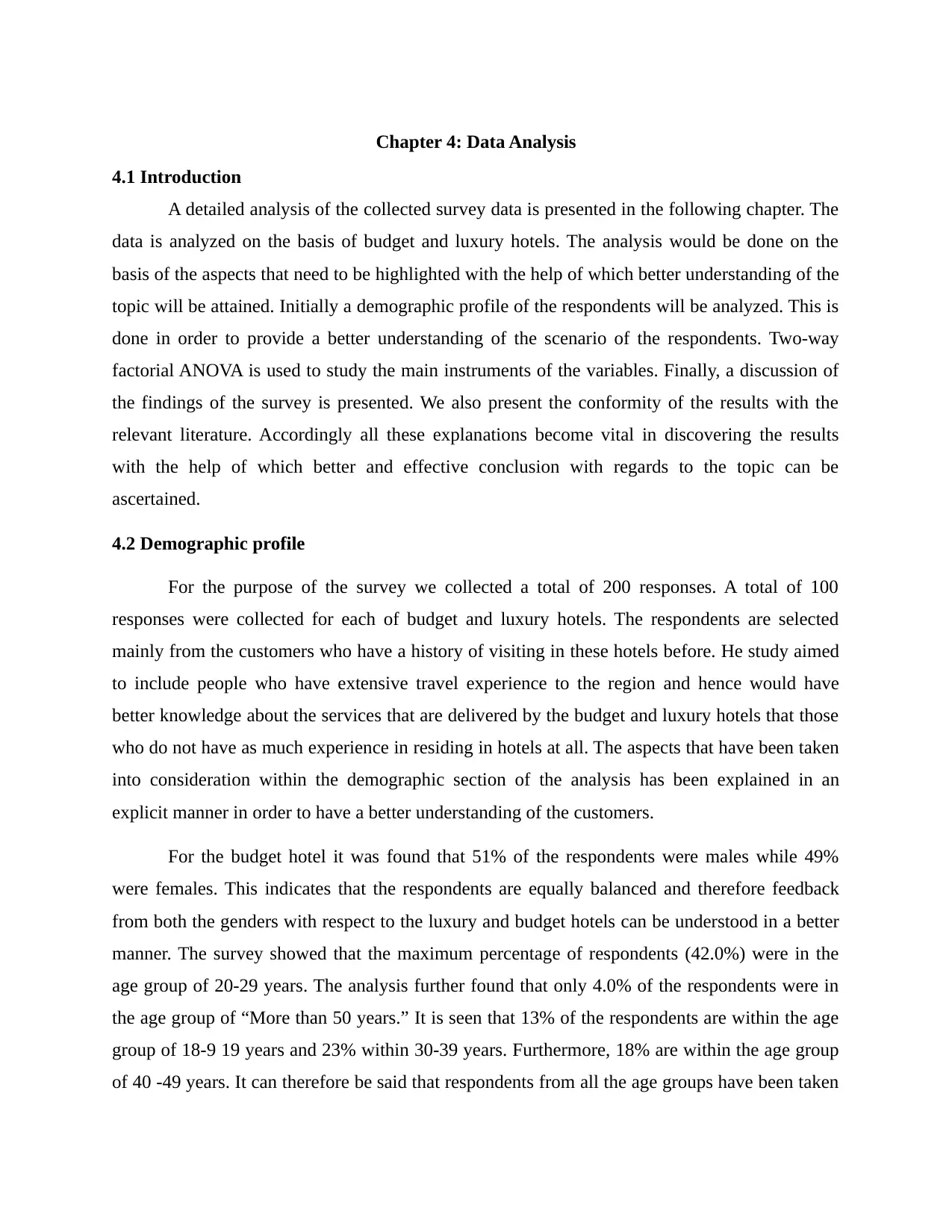
Chapter 4: Data Analysis
4.1 Introduction
A detailed analysis of the collected survey data is presented in the following chapter. The
data is analyzed on the basis of budget and luxury hotels. The analysis would be done on the
basis of the aspects that need to be highlighted with the help of which better understanding of the
topic will be attained. Initially a demographic profile of the respondents will be analyzed. This is
done in order to provide a better understanding of the scenario of the respondents. Two-way
factorial ANOVA is used to study the main instruments of the variables. Finally, a discussion of
the findings of the survey is presented. We also present the conformity of the results with the
relevant literature. Accordingly all these explanations become vital in discovering the results
with the help of which better and effective conclusion with regards to the topic can be
ascertained.
4.2 Demographic profile
For the purpose of the survey we collected a total of 200 responses. A total of 100
responses were collected for each of budget and luxury hotels. The respondents are selected
mainly from the customers who have a history of visiting in these hotels before. He study aimed
to include people who have extensive travel experience to the region and hence would have
better knowledge about the services that are delivered by the budget and luxury hotels that those
who do not have as much experience in residing in hotels at all. The aspects that have been taken
into consideration within the demographic section of the analysis has been explained in an
explicit manner in order to have a better understanding of the customers.
For the budget hotel it was found that 51% of the respondents were males while 49%
were females. This indicates that the respondents are equally balanced and therefore feedback
from both the genders with respect to the luxury and budget hotels can be understood in a better
manner. The survey showed that the maximum percentage of respondents (42.0%) were in the
age group of 20-29 years. The analysis further found that only 4.0% of the respondents were in
the age group of “More than 50 years.” It is seen that 13% of the respondents are within the age
group of 18-9 19 years and 23% within 30-39 years. Furthermore, 18% are within the age group
of 40 -49 years. It can therefore be said that respondents from all the age groups have been taken
4.1 Introduction
A detailed analysis of the collected survey data is presented in the following chapter. The
data is analyzed on the basis of budget and luxury hotels. The analysis would be done on the
basis of the aspects that need to be highlighted with the help of which better understanding of the
topic will be attained. Initially a demographic profile of the respondents will be analyzed. This is
done in order to provide a better understanding of the scenario of the respondents. Two-way
factorial ANOVA is used to study the main instruments of the variables. Finally, a discussion of
the findings of the survey is presented. We also present the conformity of the results with the
relevant literature. Accordingly all these explanations become vital in discovering the results
with the help of which better and effective conclusion with regards to the topic can be
ascertained.
4.2 Demographic profile
For the purpose of the survey we collected a total of 200 responses. A total of 100
responses were collected for each of budget and luxury hotels. The respondents are selected
mainly from the customers who have a history of visiting in these hotels before. He study aimed
to include people who have extensive travel experience to the region and hence would have
better knowledge about the services that are delivered by the budget and luxury hotels that those
who do not have as much experience in residing in hotels at all. The aspects that have been taken
into consideration within the demographic section of the analysis has been explained in an
explicit manner in order to have a better understanding of the customers.
For the budget hotel it was found that 51% of the respondents were males while 49%
were females. This indicates that the respondents are equally balanced and therefore feedback
from both the genders with respect to the luxury and budget hotels can be understood in a better
manner. The survey showed that the maximum percentage of respondents (42.0%) were in the
age group of 20-29 years. The analysis further found that only 4.0% of the respondents were in
the age group of “More than 50 years.” It is seen that 13% of the respondents are within the age
group of 18-9 19 years and 23% within 30-39 years. Furthermore, 18% are within the age group
of 40 -49 years. It can therefore be said that respondents from all the age groups have been taken
Paraphrase This Document
Need a fresh take? Get an instant paraphrase of this document with our AI Paraphraser
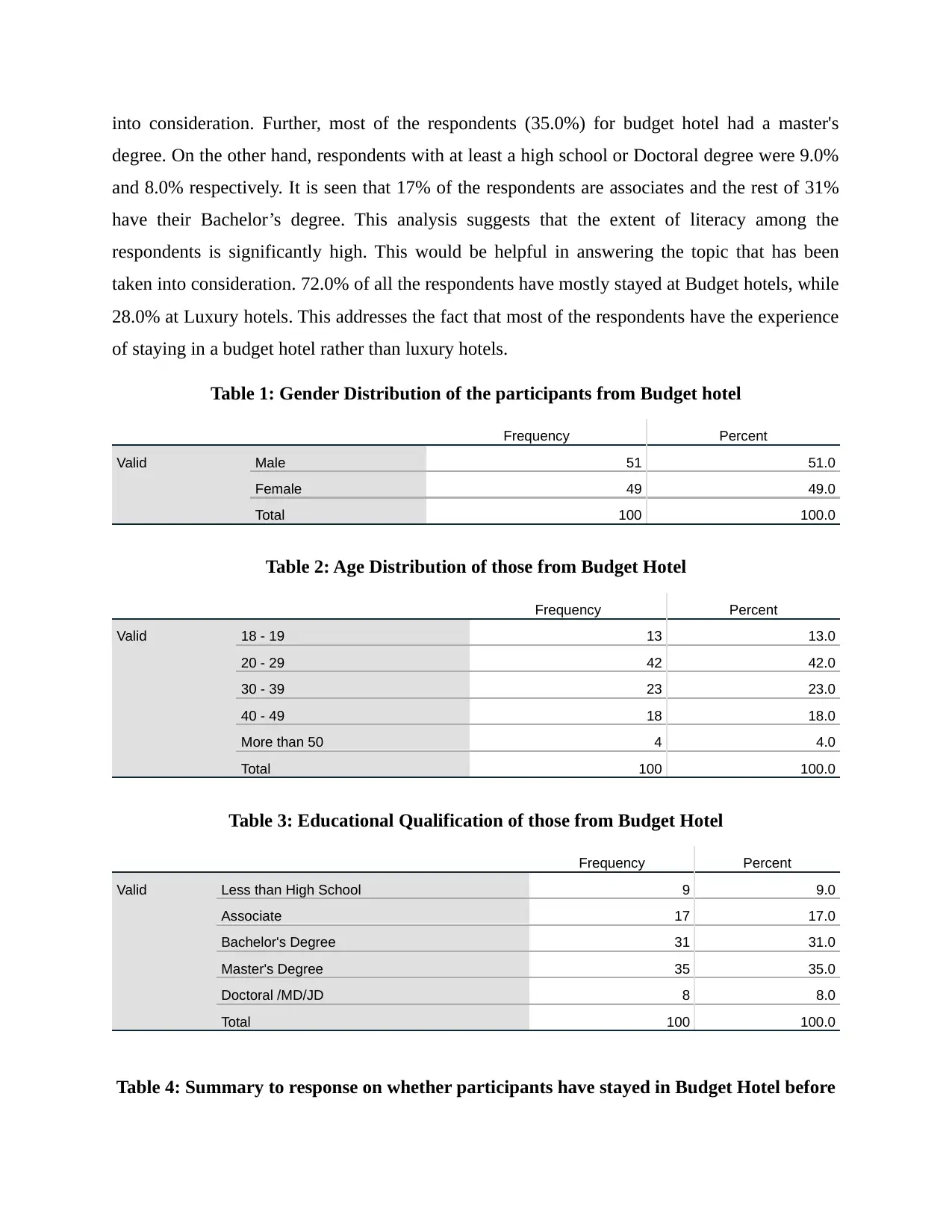
into consideration. Further, most of the respondents (35.0%) for budget hotel had a master's
degree. On the other hand, respondents with at least a high school or Doctoral degree were 9.0%
and 8.0% respectively. It is seen that 17% of the respondents are associates and the rest of 31%
have their Bachelor’s degree. This analysis suggests that the extent of literacy among the
respondents is significantly high. This would be helpful in answering the topic that has been
taken into consideration. 72.0% of all the respondents have mostly stayed at Budget hotels, while
28.0% at Luxury hotels. This addresses the fact that most of the respondents have the experience
of staying in a budget hotel rather than luxury hotels.
Table 1: Gender Distribution of the participants from Budget hotel
Frequency Percent
Valid Male 51 51.0
Female 49 49.0
Total 100 100.0
Table 2: Age Distribution of those from Budget Hotel
Frequency Percent
Valid 18 - 19 13 13.0
20 - 29 42 42.0
30 - 39 23 23.0
40 - 49 18 18.0
More than 50 4 4.0
Total 100 100.0
Table 3: Educational Qualification of those from Budget Hotel
Frequency Percent
Valid Less than High School 9 9.0
Associate 17 17.0
Bachelor's Degree 31 31.0
Master's Degree 35 35.0
Doctoral /MD/JD 8 8.0
Total 100 100.0
Table 4: Summary to response on whether participants have stayed in Budget Hotel before
degree. On the other hand, respondents with at least a high school or Doctoral degree were 9.0%
and 8.0% respectively. It is seen that 17% of the respondents are associates and the rest of 31%
have their Bachelor’s degree. This analysis suggests that the extent of literacy among the
respondents is significantly high. This would be helpful in answering the topic that has been
taken into consideration. 72.0% of all the respondents have mostly stayed at Budget hotels, while
28.0% at Luxury hotels. This addresses the fact that most of the respondents have the experience
of staying in a budget hotel rather than luxury hotels.
Table 1: Gender Distribution of the participants from Budget hotel
Frequency Percent
Valid Male 51 51.0
Female 49 49.0
Total 100 100.0
Table 2: Age Distribution of those from Budget Hotel
Frequency Percent
Valid 18 - 19 13 13.0
20 - 29 42 42.0
30 - 39 23 23.0
40 - 49 18 18.0
More than 50 4 4.0
Total 100 100.0
Table 3: Educational Qualification of those from Budget Hotel
Frequency Percent
Valid Less than High School 9 9.0
Associate 17 17.0
Bachelor's Degree 31 31.0
Master's Degree 35 35.0
Doctoral /MD/JD 8 8.0
Total 100 100.0
Table 4: Summary to response on whether participants have stayed in Budget Hotel before
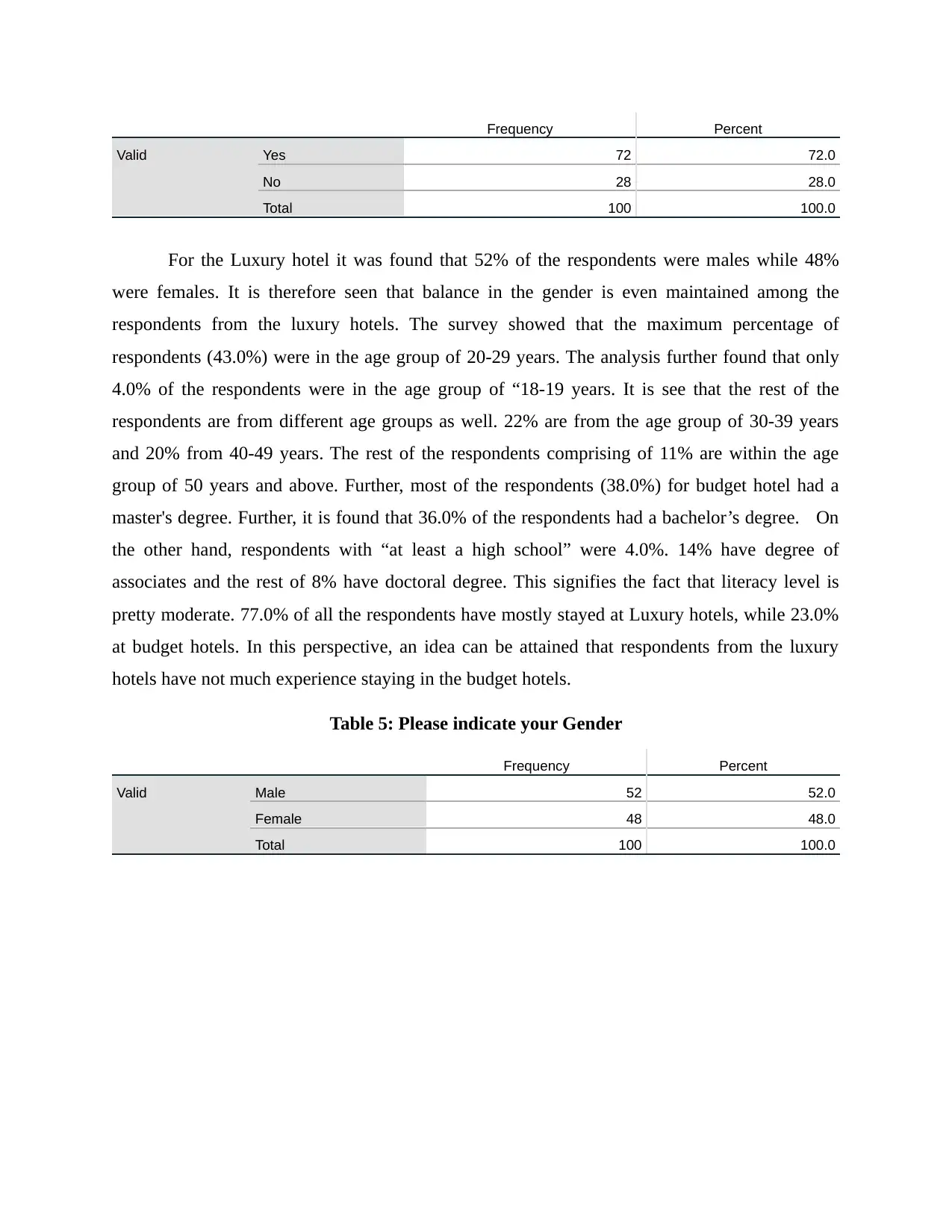
Frequency Percent
Valid Yes 72 72.0
No 28 28.0
Total 100 100.0
For the Luxury hotel it was found that 52% of the respondents were males while 48%
were females. It is therefore seen that balance in the gender is even maintained among the
respondents from the luxury hotels. The survey showed that the maximum percentage of
respondents (43.0%) were in the age group of 20-29 years. The analysis further found that only
4.0% of the respondents were in the age group of “18-19 years. It is see that the rest of the
respondents are from different age groups as well. 22% are from the age group of 30-39 years
and 20% from 40-49 years. The rest of the respondents comprising of 11% are within the age
group of 50 years and above. Further, most of the respondents (38.0%) for budget hotel had a
master's degree. Further, it is found that 36.0% of the respondents had a bachelor’s degree. On
the other hand, respondents with “at least a high school” were 4.0%. 14% have degree of
associates and the rest of 8% have doctoral degree. This signifies the fact that literacy level is
pretty moderate. 77.0% of all the respondents have mostly stayed at Luxury hotels, while 23.0%
at budget hotels. In this perspective, an idea can be attained that respondents from the luxury
hotels have not much experience staying in the budget hotels.
Table 5: Please indicate your Gender
Frequency Percent
Valid Male 52 52.0
Female 48 48.0
Total 100 100.0
Valid Yes 72 72.0
No 28 28.0
Total 100 100.0
For the Luxury hotel it was found that 52% of the respondents were males while 48%
were females. It is therefore seen that balance in the gender is even maintained among the
respondents from the luxury hotels. The survey showed that the maximum percentage of
respondents (43.0%) were in the age group of 20-29 years. The analysis further found that only
4.0% of the respondents were in the age group of “18-19 years. It is see that the rest of the
respondents are from different age groups as well. 22% are from the age group of 30-39 years
and 20% from 40-49 years. The rest of the respondents comprising of 11% are within the age
group of 50 years and above. Further, most of the respondents (38.0%) for budget hotel had a
master's degree. Further, it is found that 36.0% of the respondents had a bachelor’s degree. On
the other hand, respondents with “at least a high school” were 4.0%. 14% have degree of
associates and the rest of 8% have doctoral degree. This signifies the fact that literacy level is
pretty moderate. 77.0% of all the respondents have mostly stayed at Luxury hotels, while 23.0%
at budget hotels. In this perspective, an idea can be attained that respondents from the luxury
hotels have not much experience staying in the budget hotels.
Table 5: Please indicate your Gender
Frequency Percent
Valid Male 52 52.0
Female 48 48.0
Total 100 100.0
⊘ This is a preview!⊘
Do you want full access?
Subscribe today to unlock all pages.

Trusted by 1+ million students worldwide
1 out of 38
Related Documents
Your All-in-One AI-Powered Toolkit for Academic Success.
+13062052269
info@desklib.com
Available 24*7 on WhatsApp / Email
![[object Object]](/_next/static/media/star-bottom.7253800d.svg)
Unlock your academic potential
Copyright © 2020–2025 A2Z Services. All Rights Reserved. Developed and managed by ZUCOL.





